
Underground power
More electrification of our lives means we need a more robust network to deliver that electricity to our community.
Making the switch from overhead to underground
As we move towards a cleaner energy future with greater generation of electricity from renewable sources, there is a comparable growing demand for a reliable and safe power supply. More electrification of our lives means we need a more robust network to deliver that electricity to our community. Western Power is transforming the grid to enable industry and the community to achieve their decarbonisation goals. One important part of this is the continued roll out of underground power.
Underground power
Undergrounding the network helps us towards all elements of our vision to safely provide reliable supply, keep costs low and enable decarbonisation for our community.
Undergrounding power offers improved reliability and safety as there is a reduced risk of fallen powerlines during storm conditions or vehicle collisions with power poles. Fewer disruptions during extreme weather, means fewer power outages.
The underground network has a greater power supply capacity than the overhead network, meaning more renewable generation can be connected, and provides improved opportunities for emerging technologies.
Through our Underground Power programs, and together with mandatory underground power requirements for new developments, more than 65% of the Perth metropolitan area now benefits from underground power.
Benefits of underground power
Underground power is designed to deliver reliable and safe power, while improving street appearance and opportunities for increasing the uptake of solar and other technologies.
We are committed to working with the State Government, Local Government and the community to deliver the many benefits of underground power.
- Improved public safety - with improved streetlighting making neighbourhoods safer.
- Lower life cycle cost - underground power has minimal maintenance and operating costs.
- Improved reliability and security - once the power is underground, you’re likely to experience fewer disruptions during significant storm events, which means fewer power outages.
- Improved street appearance - who doesn’t want to live on a nice-looking street? Removing powerlines create a more aesthetically pleasing neighbourhood.
- Reduction in street tree pruning - no need to worry about trees getting in the way of poles any more! The property owner and Local Government will save on maintenance costs.
- Increased property values - the absence of poles and wires and the inclusion of new streetlighting has a positive impact on property values.
- Support emerging technologies - underground power helps pave the way for innovation and caters better to future power demand.
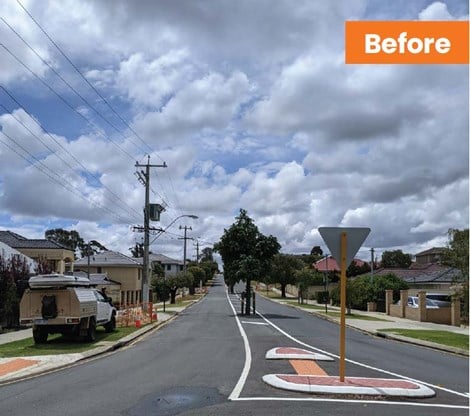 |
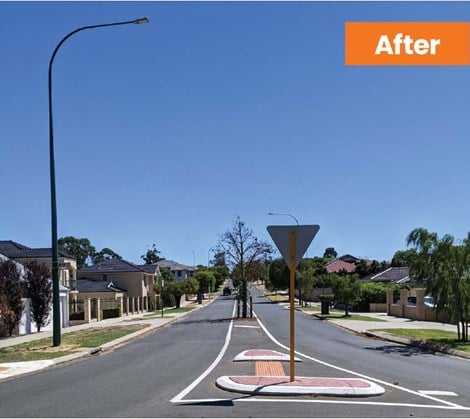 |
Photos courtesy of City of South Perth for illustration purposes only. Type and location of equipment may vary depending on project design.
Our underground power programs
The State Government has been supporting underground power programs since 1996, with more than 100,000 properties converted from overhead to underground power to date.
Now, through programs such as our network renewal Targeted Underground Power Program (TUPP), that growth is accelerating and a further 29,000 homes are set to receive underground power by 2027.
We currently manage three programs converting the overhead network to underground power:
Targeted Underground Power Program (TUPP) - Western Power selects areas based on a network driven approach in accordance with the network renewal undergrounding program. We make offers to Local Governments to complete undergrounding in parts of their Local Government, in priority order.
The cost of undergrounding is shared between the State Government, Western Power, Local Government and property owners, with the State Government's funding tiered based on socio-economic indicators.
The first TUPP project is scheduled for delivery in 2025.
TUPP is a collaboration between Local Government (WALGA), the State Government and Western Power. Targeted Underground Power Program Guidelines outline the processes, decision making pathways and responsibilities for TUPP implementation.
You can find further information on TUPP, answers to common questions about the program, and links to State Government underground power resources at wa.gov.au.
Network Renewal Undergrounding Program Pilot (NRUPP) - a program driven by Western Power targeting areas with a high density of aging overhead distribution assets.
The cost of undergrounding is shared between Western Power, the Local Government and property owners.
It is a pilot program that has been replaced with the TUPP.
Retrospective Undergrounding Projects (RUP) - Local Governments who would like to have underground power installed in an area that is not on our network driven priority list can apply for undergrounding.
Local Governments are able to apply for a Retrospective Underground Project online.
These projects are primarily funded directly by the Local Government and property owners, with a contribution from Western Power.
A previous program, the State Underground Power Program (SUPP), was a State Government initiative established in 1996 to convert overhead power underground. The final Round Six SUPP program was completed in 2024.
Is my area switching to underground power?
Western Power spends around $1 billion each year upgrading and maintaining the network to manage safety, reliability and environmental risks.
As part of our asset management process, we identify areas with assets needing replacement and determine the renewal and maintenance work that is required.
Traditionally the work involves like-for-like replacement of assets, however when identified as beneficial to the community and cost effective to do so, we may convert the overhead network to underground as part of this asset replacement.
Targeted Underground Power Program (TUPP) areas are selected through a network driven approach in accordance with our network renewal undergrounding program.
Following its annual planning cycle, Western Power has updated the network renewal map, integrating several strategic updates. The network renewal map reflects risk-based planning which can change prioritisation of potential projects. Future network risk, renewal plans and potential project areas can be impacted by multiple drivers including public safety, reliability, asset age, asset condition, and market factors.
View indicative map of our network renewal underground program.
Current projects
Note: Project timelines are subject to change.
| Local government | City of Stirling |
| Project type | Targeted Underground Power Program (TUPP) |
| Scheduled start date | Q3 2026 |
| Scheduled completion date | Under development |
| Project map | Download map |
| Local government | Town of Bassendean |
| Project type | Targeted Underground Power Program (TUPP) |
| Scheduled start date | Under development |
| Scheduled completion date | Under development |
| Project map | Download map |
| Local governments | City of Canning Town of Victoria Park |
| Project type | Targeted Underground Power Program (TUPP) |
| Scheduled start date | Under development |
| Scheduled completion date | Under development |
| Project map | Download map |
| Local government | Town of Victoria Park |
| Project type | Targeted Underground Power Program (TUPP) |
| Scheduled start date | Under development |
| Scheduled completion date | Under development |
| Project map | Download map |
| Local government | City of Cockburn |
| Project type | Targeted Underground Power Program (TUPP) |
| Scheduled start date | Under development |
| Scheduled completion date | Under development |
| Project map | Download map |
| Local government | City of Stirling |
| Project type | Network Renewal Undergrounding Program Pilot (NRUPP) |
| Scheduled start date | Q1 2025 |
| Scheduled completion date | Q4 2026 |
| Project map | Download map |
| Local government | City of Cockburn |
| Project type | Targeted Underground Power Program (TUPP) |
| Scheduled start date | Under development |
| Scheduled completion date | Under development |
| Project map | Under development |
| Local government | City of Nedlands |
| Project type | Retrospective Underground Power Project (RUPP) |
| Scheduled start date | Under development |
| Scheduled completion date | Under development |
| Project map | Download map |
| Local government | City of Vincent |
| Project type | Targeted Underground Power Program (TUPP) |
| Scheduled start date | Under development |
| Scheduled completion date | Under development |
| Project map | Download map |
| Local government | City of Bayswater |
| Project type | State Underground Power Project (SUPP) |
| Project complete | We are pleased to announce the successful completion of the project on November 14, 2024. A 12-month warranty period is now in effect for rectifying any faults associated with the project. For any queries or issues during this period, please contact us at 13 10 87. |
| Project map | Download map |
| Local government | City of Melville |
| Project type | Targeted Underground Power Program (TUPP) |
| Scheduled start date | Q2 2026 |
| Scheduled completion date | Under development |
| Project map | Download map |
| Local government | City of Vincent |
| Project type | Targeted Underground Power Program (TUPP) |
| Scheduled start date | Under development |
| Scheduled completion date | Under development |
| Project map | Under development |
| Local government | City of Nedlands |
| Project type | Retrospective Underground Power Project (RUPP) |
| Scheduled start date | Q3 2024 |
| Scheduled completion date | Q3 2025 |
| Project map | Download map |
| Local government | City of Nedlands |
| Project type | Retrospective Underground Power Project (RUPP) |
| Scheduled start date | Q1 2025 |
| Scheduled completion date | Q2 2026 |
| Project map | Download map |
| Local government | City of Vincent and City of Stirling |
| Project type | Network Renewal Undergrounding Program Pilot (NRUPP) |
| Scheduled start date | Q1 2025 |
| Scheduled completion date | Q3 2026 |
| Project map | Download map |
| Local government | City of Vincent |
| Project type | Network Renewal Undergrounding Program Pilot (NRUPP) |
| Scheduled start date | Under development |
| Scheduled completion date | Under development |
| Project map | Download map |
| Local government | City of Stirling |
| Project type | Targeted Underground Power Program (TUPP) |
| Scheduled start date | TBC |
| Scheduled completion date | TBC |
| Project map | Download map |
| Local government | City of Vincent |
| Project type | Network Renewal Undergrounding Program Pilot (NRUPP) |
| Scheduled start date | Under development |
| Scheduled completion date | Under development |
| Project map | Download map |
| Local government | City of Rockingham |
| Project type | Targeted Underground Power Program (TUPP) |
| Scheduled start date | Under development |
| Scheduled completion date | Under development |
| Project map | Download map |
| Local government | City of Fremantle |
| Project type | Targeted Underground Power Program (TUPP) |
| Scheduled start date | Under development |
| Scheduled completion date | Under development |
| Project map | Download map |
| Local government | City of Cockburn |
| Project type | State Underground Power Project (SUPP) |
| Project complete |
We are pleased to announce that the project was successfully completed on the 30th August 2024. A 12-month warranty period is now in effect for the rectification of any faults that may arise from these works. For any queries or issues during this period, please contact us at 13 10 87. |
| Project map | Download map |
| Local government updates | Underground Power | City of South Perth |
| Project type | Retrospective Underground Power Project (RUPP) |
| Scheduled start date | Quarter 4, 2022 |
| Scheduled completion date | Quarter 3, 2025 |
| Project map | Download map |
| Local government updates | Underground Power | City of South Perth |
| Project type | Network Renewal Undergrounding Program Pilot (NRUPP) |
| Scheduled start date | Quarter 3, 2025 |
| Scheduled completion date | Quarter 2, 2027 |
| Project map | Download map |
| Local government | City of Cockburn |
| Project type | Targeted Underground Power Program (TUPP) |
| Scheduled start date | Under development |
| Scheduled completion date | Under development |
| Project map | Under development |
| Local government | City of Swan |
| Project type | Targeted Underground Power Program (TUPP) |
| Scheduled start date | 2025 |
| Scheduled completion date | Under development |
| Project map | Download map |
| Local government | City of Stirling |
| Project Type | Targeted Underground Power Program (TUPP) |
| Scheduled Start date | Q3 2026 |
| Scheduled completion date | Under development |
| Project Map | Download map |
| Local government | City of Vincent |
| Project type | Targeted Underground Power Program (TUPP) |
| Scheduled start date | Under development |
| Scheduled completion date | Under development |
| Project map | Under development |
| Local government | City of Melville |
| Project type | Targeted Underground Power Program (TUPP) |
| Scheduled start date | Q2 2025 |
| Scheduled completion date | Under development |
| Project map | Download map |
| Local government | City of Swan |
| Project type | Targeted Underground Power Program (TUPP) |
| Scheduled start date | Under development |
| Scheduled completion date | Under development |
| Project map | Under development |
What you can expect when underground power is coming to your suburb
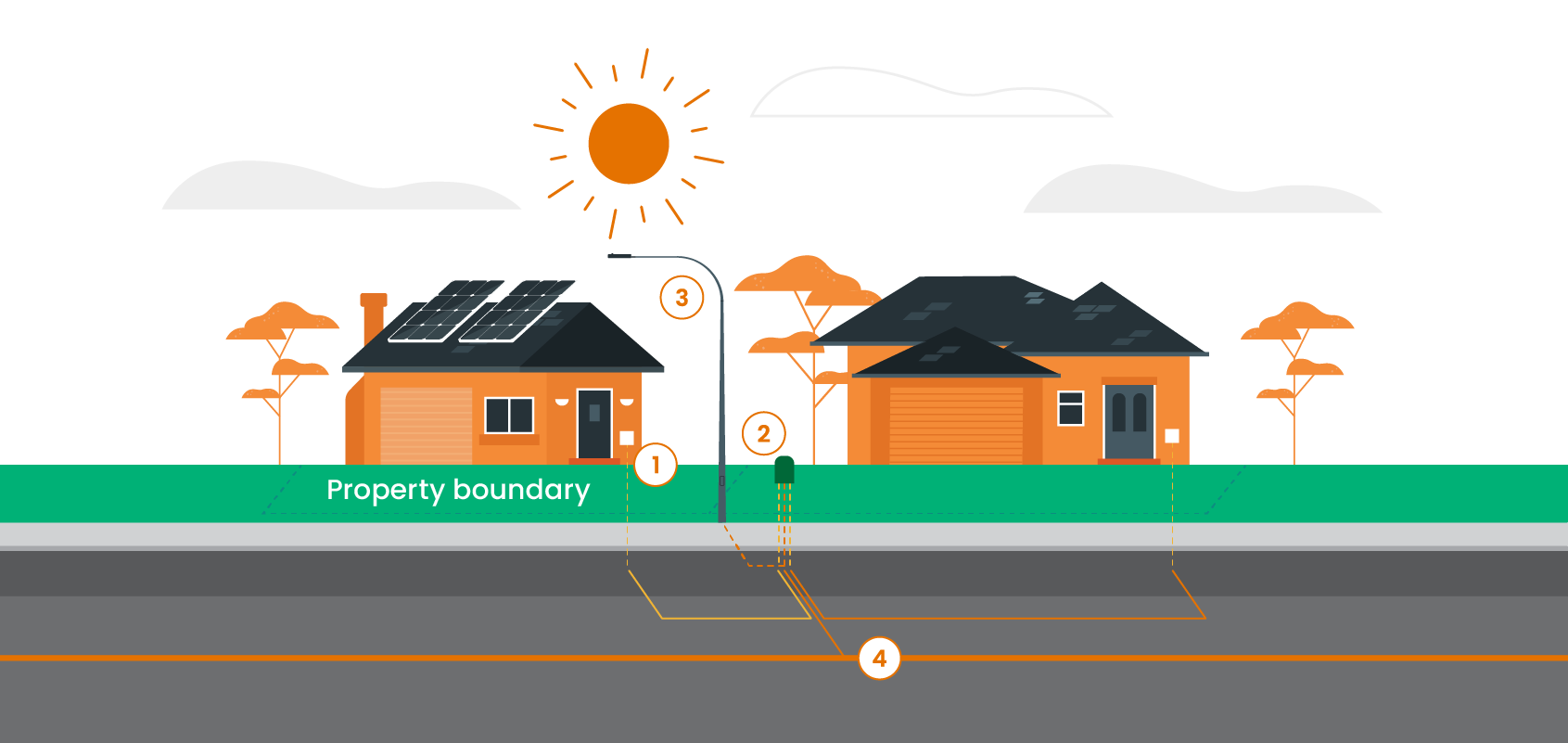
1. Customer mains connectionThe cable connecting your house (meter box) to the pillar will be installed at a depth of 500 - 650mm. It becomes your property as the landowner. |
2. Pillar (green dome)The connection point between your home and the network is installed on your property boundary. Typically one unit services two properties. |
3. StreetlightsNew LED streetlights will be installed to Australian Standards. Compared to conventional streetlights, the new LED system provides enhanced illumination and may appear brighter. |
4. Distribution networkThe network of high voltage/low voltage underground cables that provide power to your area. |
Additional equipment in your area
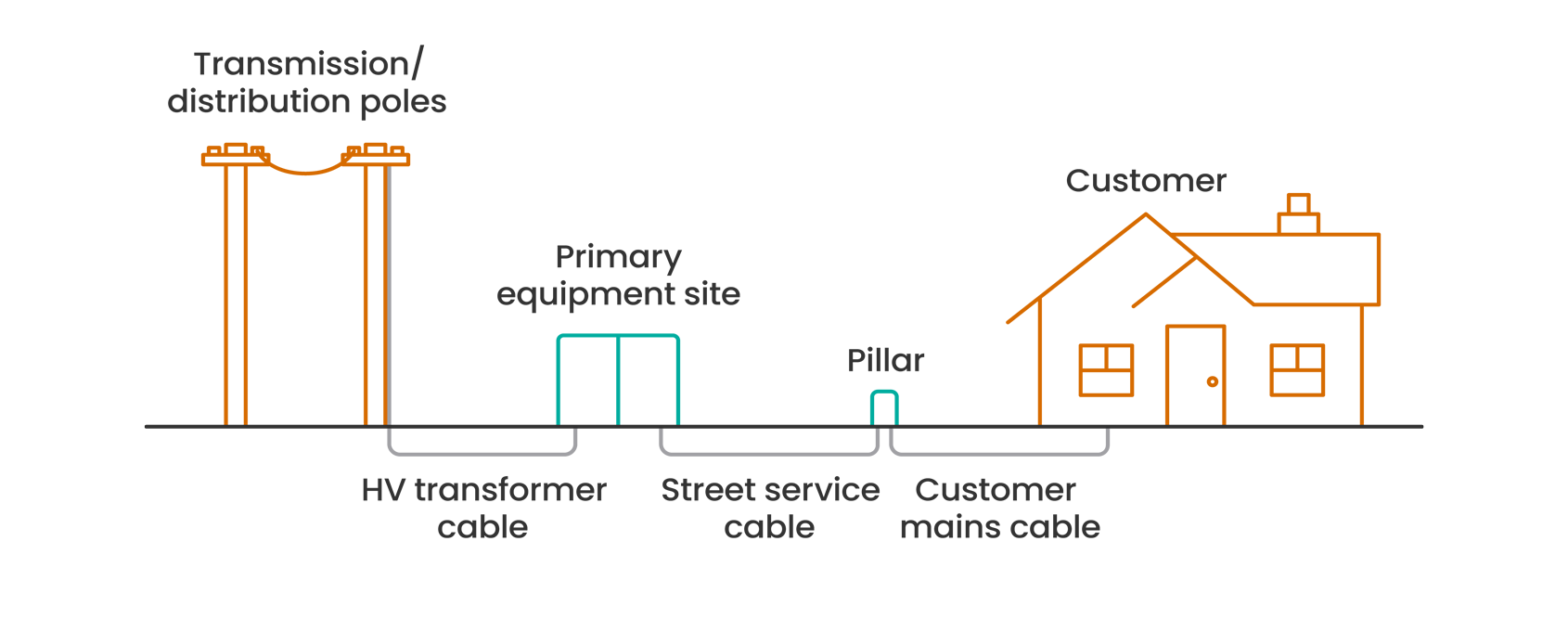
Transmission lines carry bulk electricity at high voltages from power stations to substations, where power is transformed for distribution to customers. Overhead transmission lines in your area will not be underground due to the high cost of undergrounding transmission infrastructure.
Primary equipment such as ground mounted transformers and switchgear units, enables the distribution of electricity to customers through the underground network. This equipment was previously located on overhead poles, and as part of the conversion to underground power we move them to the ground.
Primary equipment
Integral to this evolution is primary equipment. This isn’t just hardware; it’s the linchpin that channels electricity into our homes and businesses. Primary equipment has the following role:
- Ensures a stable connection for your electrical needs, swiftly reconfiguring networks duringoutages.
- Localises faults, affecting fewer residents during disruptions.
- Adapts to community power demands with automated switching between circuits.
- Enhances voltage regulation, ensuring a stable energy flow to homes and businesses.
- Provides data to help us make decisions about our community’s energy needs.
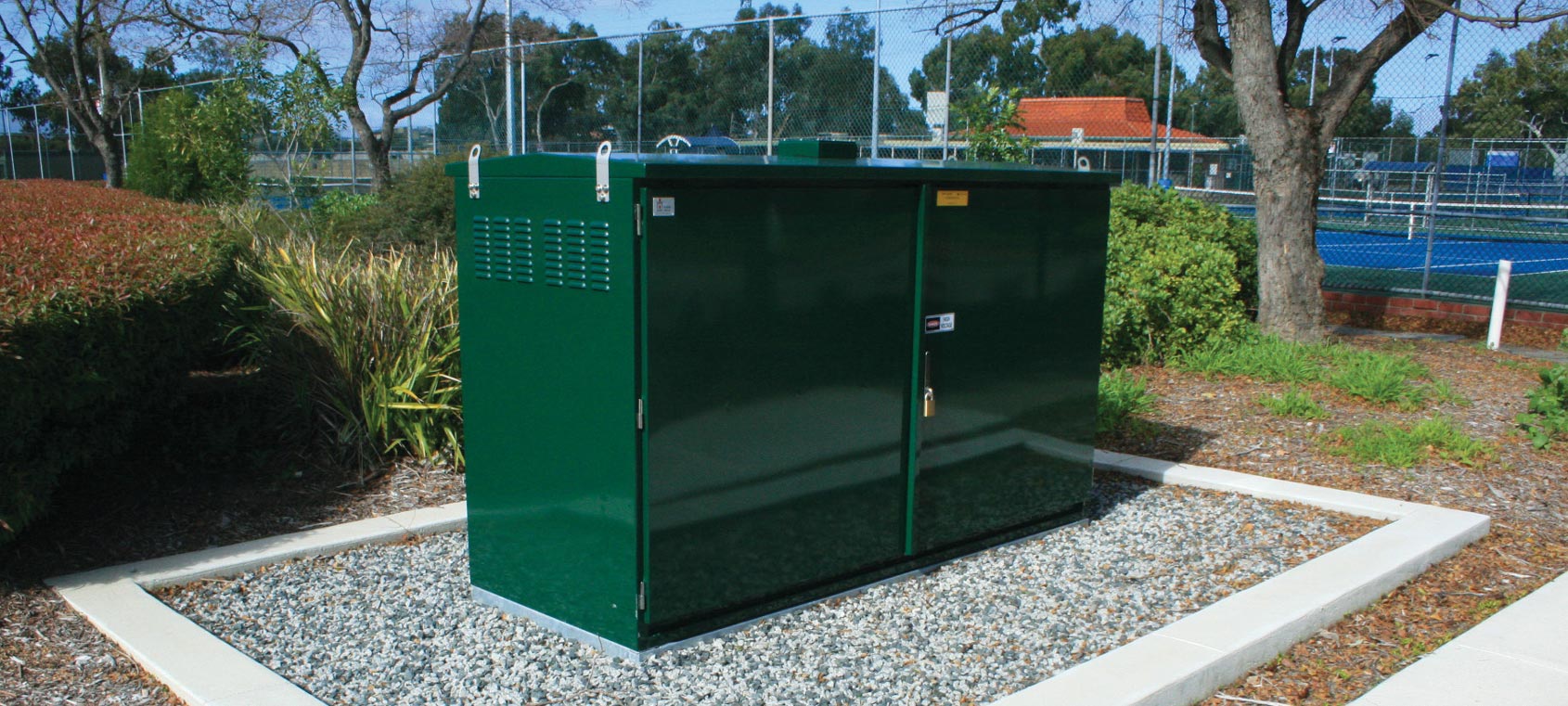
Types and placement of primary equipment
When moving power lines underground and removing poles, other gear needs to come down as well! These various primary equipment types are:
- Transformers: Converting higher voltages to a safe level for your home and local businesses.
- High voltage switchgear: Protecting the system’s integrity and allowing nimble maintenance without extensive outages.
- Low voltage kiosks: Distributing power to multiple premises, designed for quick recovery from faults.
Construction information
While the underground power project is being delivered you may experience some impacts from the construction works. We’re committed to keeping you informed and minimising disruptions while this essential work is underway. Download our guide on what you can expect during construction.
FAQs
The cost for each project is determined based on a number of factors such as population density, network load requirements, topography and ground conditions.
Each underground power program has a different funding model.
Targeted Underground Power Program (TUPP)
The cost of undergrounding is shared between the State Government, Western Power, Local Government and property owners, with the State Government's funding tiered based on socio-economic indicators.
These projects target areas with a high proportion of aging distribution overhead assets that are coming to the end of their service life....
Targeted Underground Power Program (TUPP)
Yes. The underground power's service charges applicable to rate payers has two components:
- Network services charge (or network infrastructure costs); and
- Consumer mains charge.
Customer funding contributions for underground power connections are determined by each Local Government Authority. Generally, property owners with an existing underground consumer main (green dome) will only be charged for the network services component.
Please contact your local government for information on rate payer contributions towards an underground power program ...
With every project, a new LED street lighting system is designed and installed to the latest Australian Standards. Each project is different and the positioning of new streetlights is also reviewed during the design stage.
You’ll find that around 10% more lights are installed because they are positioned more closely and generally alternate from one side of the road to the other. Modern light poles are designed to collapse if hit by vehicles to reduce injuries and damage.
Distribution network poles and wires will be removed within the project area only. Transmission poles and wires won’t be.
The contractor carrying out the project will repair any damage caused by the works. Please report any damage not remedied to the contractor as soon as possible. At the start of the project you’ll receive information in your mailbox with the contractor’s contact details.
All street verges are video-recorded before any work commences as a record. If your verge is damaged, it will be reinstated as close as practical to its original condition.
- Project details including design, timing, costs and funding – your local government
- Project works impacting residents – Contractor
When construction is ready to commence, you’ll receive a note in your letterbox with the contact details of the contractor carrying out the work. - Underground Power general information – Western Power
If you would like to upgrade your power supply you will need to contact Western Power on 13 10 87 or submit an application online to increase your power supply.
Any application for an upgrade would be considered separately to the underground power project in your area.
Your home’s electricity supply should be safely maintained at all times. Please consult a qualified electrical contractor if you have any concerns to ensure you and your property are safe.
Our contractor will let you know if they find unsafe electrical wiring as they work to connect your property to the new underground network and will provide you with a Customer Pack outlining any electrical issues at the property. You will need to engage a licensed electrical contractor to rectify the issue and make your property safe before our contractor returns to connect your property to the new...